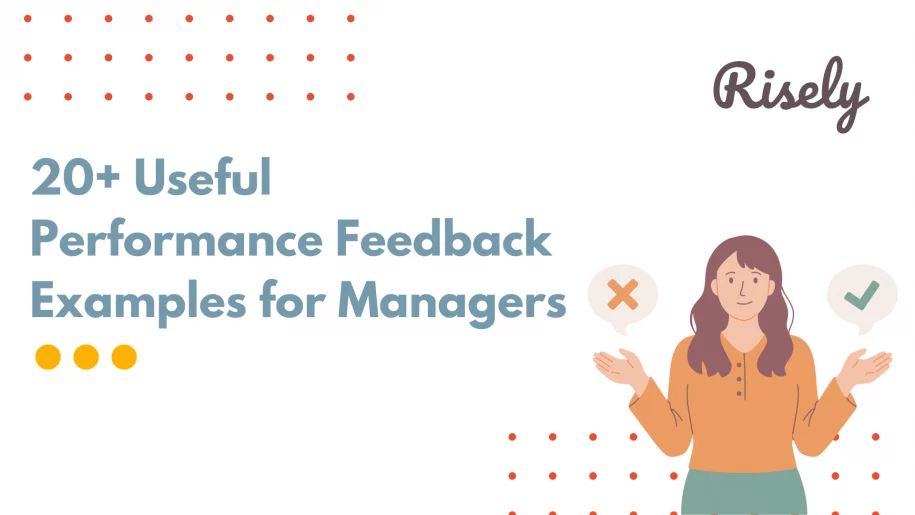20+ Useful Performance Feedback Examples for Managers
As a manager, giving feedback to your employees is one of the most critical elements in ensuring that they are motivated, engaged, and productive. Performance feedback is a constructive tool that helps employees understand how well they perform their jobs. In this blog post, we will explore performance feedback and why managers need to give it regularly. We will also cover the different types of performance feedback, including positive and constructive feedback examples for adaptability, integrity, strengths, weaknesses, leadership, teamwork, improvement, quality of work, and time management. Additionally, we will provide tips on common mistakes to avoid when giving performance feedback. By the end of this article, you can apply these tips to offer adequate performance feedback to your team members and help them reach their full potential.- 20+ Useful Performance Feedback Examples for Managers
- What is Performance Feedback?
- Key Features of Effective Performance Feedback
- Performance Feedback Examples for Adaptability
- Performance Feedback Examples for Integrity
- Performance Feedback Examples for Strengths and Weaknesses
- Performance Feedback Examples for Leadership
- Performance Feedback Examples for Teamwork
- Performance Feedback Examples for Improvement
- Performance Feedback Examples for Time Management
- Common Mistakes to Avoid in Performance Feedback
- Find more free resources here!
- Conclusion
- Other Related Blogs
What is Performance Feedback?
Performance feedback is a valuable tool that provides insights for improvement, identifies strengths and areas of development, promotes open communication, supports professional growth, and encourages continuous learning. It is crucial in enhancing performance and facilitating personal and professional development. Read more: Performance Management 101 for Leaders: 5 Steps to Ace the ProcessWhy is Performance Feedback Important for Managers?
Performance feedback is crucial for managers as it enhances employee engagement, improves team performance, identifies areas for development, builds stronger relationships, and drives better results. It plays a vital role in boosting job satisfaction and achieving organizational goals.Key Features of Effective Performance Feedback
Positive feedback recognizes and highlights achievements and successes, motivating employees to continue their excellent work. On the other hand, constructive feedback addresses areas for improvement, guiding how to enhance performance. Specific feedback is essential in providing clarity and actionable steps for employees. Timely feedback ensures prompt course correction, preventing issues from escalating. Managers must offer a balanced feedback approach, acknowledging strengths and weaknesses creating a well-rounded evaluation of an employee’s performance.Performance Feedback Examples for Adaptability
- Positive Feedback: “You demonstrated impressive adaptability when you quickly adjusted your project strategy in response to unexpected market changes. Your ability to pivot and find new opportunities was instrumental in our team’s success.”
- Development Feedback: “While you excel in adapting to changes within your immediate team, there may be room for improvement in adapting to cross-functional collaborations. Consider enhancing your communication skills to better align with colleagues from different departments.”
- Balanced Feedback: “Your adaptability is evident in your ability to embrace new technologies and workflows. However, this adaptability can occasionally lead to frequent changes that disrupt team stability. Finding a balance between innovation and stability is key.”
Performance Feedback Examples for Integrity
- Positive Feedback: “Your consistent adherence to our company’s ethical guidelines demonstrates unwavering integrity. Your actions have set a positive example for your colleagues and strengthened our organizational culture.”
- Development Feedback: “While your integrity is unquestionable, there have been lapses in communication that could be perceived as dishonesty. Focusing on clear and transparent communication will help uphold our commitment to integrity.”
- Balanced Feedback: “You maintain a high level of integrity in your work, but it’s important to remember that integrity also extends to interactions with colleagues. Continuously demonstrate trustworthiness in all aspects of your role.”
Performance Feedback Examples for Strengths and Weaknesses
- Strengths Feedback: “Your exceptional problem-solving skills and attention to detail have consistently impressed us. These strengths have led to outstanding outcomes in your recent projects.”
- Weaknesses Feedback: “While your technical skills are remarkable, there may be opportunities to improve your public speaking abilities. Developing this skill will help you communicate your ideas more effectively in meetings and presentations.”
- Balanced Feedback: “Your analytical thinking and creativity are evident in your work, but there’s room for improvement in time management. Focusing on better time allocation will enhance your overall effectiveness.”
Performance Feedback Examples for Leadership
- Positive Feedback: “Your inspirational leadership style empowers team members to reach their full potential. Your guidance and mentorship have increased productivity and a strong sense of camaraderie within the team.”
- Development Feedback: “As a leader, there’s an opportunity to delegate tasks more effectively and involve team members in decision-making. Encouraging greater participation will further boost team morale and innovation.”
- Balanced Feedback: “Your leadership is characterized by a strong vision, but occasionally, you may benefit from being more receptive to alternative viewpoints. Embracing diverse perspectives can lead to more comprehensive decision-making.”
Other Interesting Reads
Performance Feedback Examples for Teamwork
- Positive Feedback: “Your collaborative approach to teamwork is exceptional. Your ability to foster cooperation and create a supportive environment has significantly contributed to the success of our projects.”
- Development Feedback: “While you excel in collaborating with your immediate team, consider extending your collaboration skills to cross-functional projects. Building relationships beyond your department will enhance overall teamwork.”
- Balanced Feedback: “Your teamwork skills shine in group projects, but occasionally, you may prioritize group harmony over addressing conflicts. Striking a balance between harmony and constructive conflict resolution will further strengthen teamwork.”
Performance Feedback Examples for Improvement
- Positive Feedback: “Your commitment to continuous improvement is commendable. Your active skill development engagement and willingness to seek feedback demonstrate your dedication to personal and professional growth.”
- Development Feedback: “To further enhance your improvement journey, consider setting more specific and measurable goals. This will provide clear direction and allow for better tracking of your progress.”
- Balanced Feedback: “Your enthusiasm for improvement is evident, but ensure it doesn’t lead to unnecessary self-criticism. Embrace setbacks as opportunities for learning and growth rather than as failures.”
Performance Feedback Examples for Time Management
- Positive Feedback: “Your exceptional time management skills are reflected in your consistent ability to meet deadlines and exceed expectations. Your efficient work processes have positively impacted project outcomes.”
- Development Feedback: “While you excel in managing your tasks, there may be room to better prioritize and delegate when faced with a heavy workload. It will prevent burnout and ensure sustainable productivity.”
- Balanced Feedback: “Your time management is generally strong, but occasionally, the pursuit of perfection may lead to overcommitment. Striking a balance between quality and timeliness is essential for optimal time management.”
Common Mistakes to Avoid in Performance Feedback
Focusing Only on the Negative
In providing performance feedback, it is essential to acknowledge an employee’s strengths and areas of improvement. Constructive feedback is crucial in helping employees grow, but it should be balanced with positive feedback for a well-rounded review. Instead of dwelling on mistakes, focusing on solutions that can help the employee improve is essential. Additionally, encouraging open communication can create an environment where concerns can be addressed and answers can be found. Incorporating techniques like a feedback sandwich can help you balance ideas.Not Being Specific Enough
It is crucial to be specific and detailed to provide performance feedback effectively. Use specific examples to illustrate both areas of success and areas needing improvement. You can avoid any confusion or misinterpretation by giving clear and concise feedback. Instead of making general statements, address specific behaviors or actions that require attention. Additionally, offering particular suggestions for improvement will help guide employees’ development. Performance metrics can also provide objective feedback and enhance the review process. By being specific, you can ensure your feedback is actionable and impactful.Allowing Bias to Affect the Feedback
When providing performance feedback examples, evaluating employees based on their performance rather than personal biases is essential. Managers should strive for objectivity and be aware of unconscious biases affecting their feedback. It is crucial to base feedback on observable facts and evidence, considering multiple perspectives before delivering it. By providing fair and unbiased feedback, managers can ensure an appropriate employee evaluation process. This approach promotes a positive work environment and supports the growth and development of the team as a whole.Find more free resources here!
- Questions To Ask And Never Ask : A Comprehensive Guide On Performance Reviews
- 60+ Performance Appraisal Comments: Constructive Feedback for Growth
- 37 Constructive Feedback Examples to Supercharge Your Leadership
- 7 Free Templates of Performance Review and Helpful Resources
Conclusion
Effective performance feedback is essential for managers to support the growth and development of their team members. Positive feedback reinforces good behavior and motivates employees, while constructive feedback helps them identify areas for improvement. Managers must be specific, unbiased, and focused on strengths and weaknesses. Avoiding common mistakes, such as solely focusing on the negative or not providing enough specificity. Remember, performance feedback is a powerful tool to inspire and empower your team members to reach their full potential. By giving thoughtful and well-rounded feedback, you can create a culture of continuous improvement and drive success within your organization.Constructive feedback can make or break your team’s performance.
Review your skills for free today to ensure that you are not making common mistakes.
Other Related Blogs
Assertive Feedback Techniques ft. Gurleen Baruah
Assertive Feedback Techniques ft. Gurleen Baruah Let’s be real—giving feedback as a manager isn’t always easy. Say too little, and nothing changes. Say too much, and it might come off…
How to ask for feedback from employees? | Gurleen Baruah
How to ask for feedback from employees? | Gurleen Baruah Feedback is a two way street. This podcast took managers on a trip down the other side. As managers, we…
Let’s Reverse the Gaze of Radical Candor?
Let’s Reverse the Gaze of Radical Candor? Have you heard about Radical Candor? It’s a book by Kim Scott that first came out in 2017. The tagline is “Caring Personally…
How To Become A Leadership Coach In 5 Steps
How To Become A Leadership Coach In 5 Steps Becoming a leadership coach is a fulfilling and rewarding career path for those who are passionate about helping others develop their…


